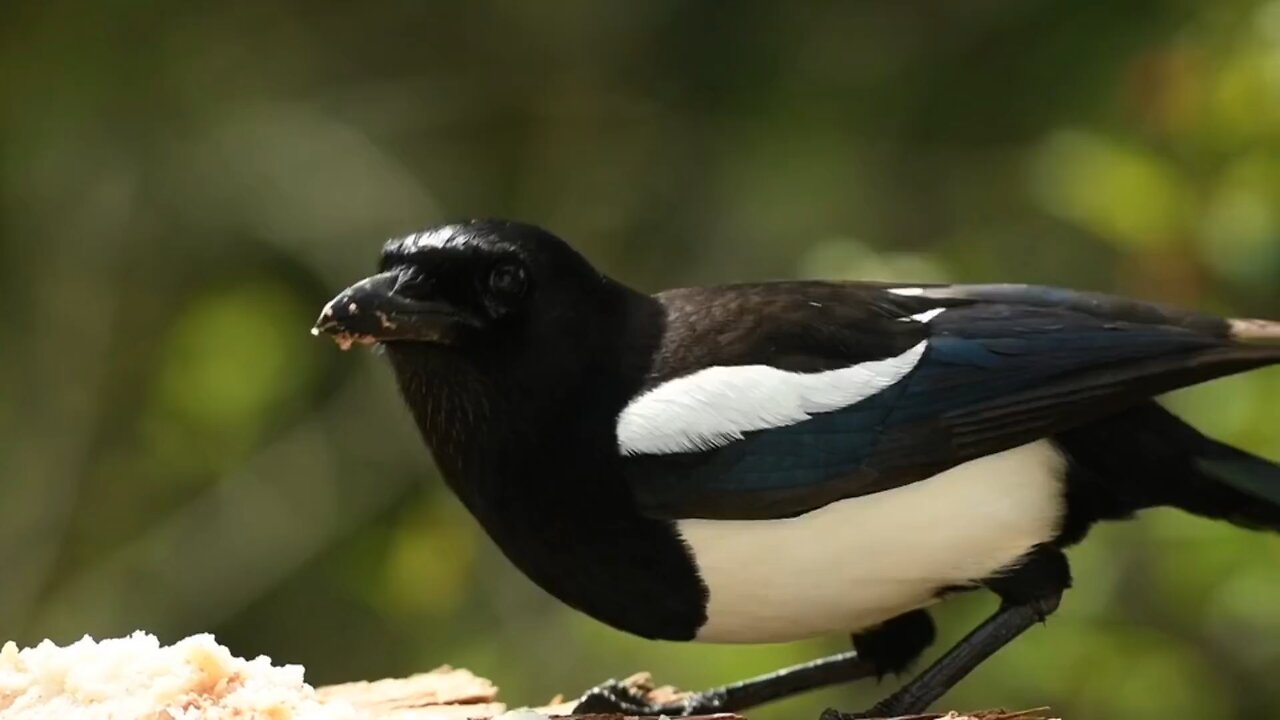Premium Only Content

"The Eurasian Magpie: Master of Adaptation and Intelligence"
The Eurasian magpie (*Pica pica*) is a striking and intelligent bird found across Europe, Asia, and parts of North Africa. It is known for its distinctive appearance and complex behaviors. Here’s more about the Eurasian magpie:
### Physical Characteristics:
- **Appearance:** The Eurasian magpie is known for its striking black-and-white plumage. Its body is mostly white with black wings, tail, and head. The feathers often have an iridescent sheen that can appear green or blue in different lights. The tail is long and has a noticeable, pointed shape.
- **Size:** It measures about 44-46 cm (17-18 inches) in length, with a wingspan of 52-62 cm (20-24 inches). It weighs between 150-250 grams (5.3-8.8 ounces).
- **Beak and Legs:** The beak is strong and slightly curved, adapted for a varied diet. The legs are black and sturdy, aiding in foraging and perching.
### Habitat and Distribution:
- **Range:** The Eurasian magpie has a wide range across Europe, Asia, and North Africa. Its range extends from the Iberian Peninsula and British Isles in the west to Japan and the Korean Peninsula in the east, and from Scandinavia in the north to the Mediterranean region in the south.
- **Habitat:** It inhabits a variety of environments, including woodlands, farmland, urban areas, and open country. It prefers areas with a mix of open spaces and trees or shrubs for nesting.
### Behavior and Diet:
- **Diet:** Eurasian magpies are omnivorous and have a varied diet that includes insects, small animals, fruits, seeds, and carrion. They are opportunistic feeders and will take advantage of available food sources.
- **Foraging:** They are known for their intelligence and problem-solving abilities. Magpies use tools and exhibit complex foraging behaviors, such as caching food for later use.
- **Social Structure:** Eurasian magpies are social birds that often form small family groups or flocks. They are known for their complex vocalizations and social interactions. During the breeding season, they form pairs and defend territories.
### Reproduction:
- **Nesting:** Magpies build large, dome-shaped nests high in trees or shrubs. The nests are constructed from twigs, mud, and other materials, and are lined with softer materials. They are typically built by both parents.
- **Eggs and Chicks:** The female lays 6-10 eggs, which are incubated for about 17-19 days. Both parents help in feeding the chicks, which fledge (leave the nest) about 25-30 days after hatching.
### Intelligence and Behavior:
- **Problem-Solving:** Eurasian magpies are highly intelligent and have demonstrated advanced problem-solving skills. They are known to use tools, recognize themselves in mirrors (a test of self-awareness), and exhibit complex behaviors like planning for future needs.
- **Vocalizations:** They have a diverse range of vocalizations used for communication, including alarm calls, territorial calls, and social interactions within the flock.
### Conservation and Threats:
- **Status:** The Eurasian magpie is generally considered a species of "Least Concern" by the International Union for Conservation of Nature (IUCN) due to its widespread distribution and stable population.
- **Threats:** While the species is not currently at risk, local populations can be affected by habitat loss, changes in land use, and persecution due to their association with agricultural damage or predation on poultry.
### Cultural Significance:
- **Folklore and Mythology:** In various cultures, the Eurasian magpie has been associated with folklore and symbolism. In some cultures, magpies are seen as omens or symbols of good fortune, while in others, they are considered mischievous or unlucky.
The Eurasian magpie is a fascinating bird known for its intelligence, adaptability, and striking appearance. Its ability to thrive in diverse environments and its complex social behaviors make it a subject of interest for ornithologists and bird enthusiasts alike.
-
 4:31
4:31
CoachTY
15 hours ago $10.62 earnedCOINBASE AND DESCI !!!!
45.2K6 -
 10:02
10:02
MichaelBisping
14 hours agoBISPING: "Was FURY ROBBED?!" | Oleksandr Usyk vs Tyson Fury 2 INSTANT REACTION
7.27K7 -
 8:08
8:08
Guns & Gadgets 2nd Amendment News
2 days ago16 States Join Forces To Sue Firearm Manufacturers Out of Business - 1st Target = GLOCK
59.5K60 -
 10:17
10:17
Dermatologist Dr. Dustin Portela
1 day ago $10.07 earnedOlay Cleansing Melts: Dermatologist's Honest Review
69.8K5 -
 1:02:20
1:02:20
Trumpet Daily
2 days ago $28.93 earnedObama’s Fake World Comes Crashing Down - Trumpet Daily | Dec. 20, 2024
45.1K40 -
 6:29
6:29
BIG NEM
23 hours agoCultivating God Mode: Ancient Taoist NoFap Practices
36.9K9 -
 30:53
30:53
Uncommon Sense In Current Times
1 day ago $8.86 earned"Pardon or Peril? How Biden’s Clemency Actions Could Backfire"
56.3K4 -
 40:01
40:01
CarlCrusher
21 hours agoSkinwalker Encounters in the Haunted Canyons of Magic Mesa - ep 4
52.4K2 -
 59:44
59:44
PMG
1 day ago $6.77 earned"BETRAYAL - Johnson's New Spending Bill EXPANDS COVID Plandemic Powers"
58.7K22 -
 6:48:50
6:48:50
Akademiks
19 hours agoKendrick Lamar and SZA disses Drake and BIG AK? HOLD UP! Diddy, Durk, JayZ update. Travis Hunter RUN
180K31